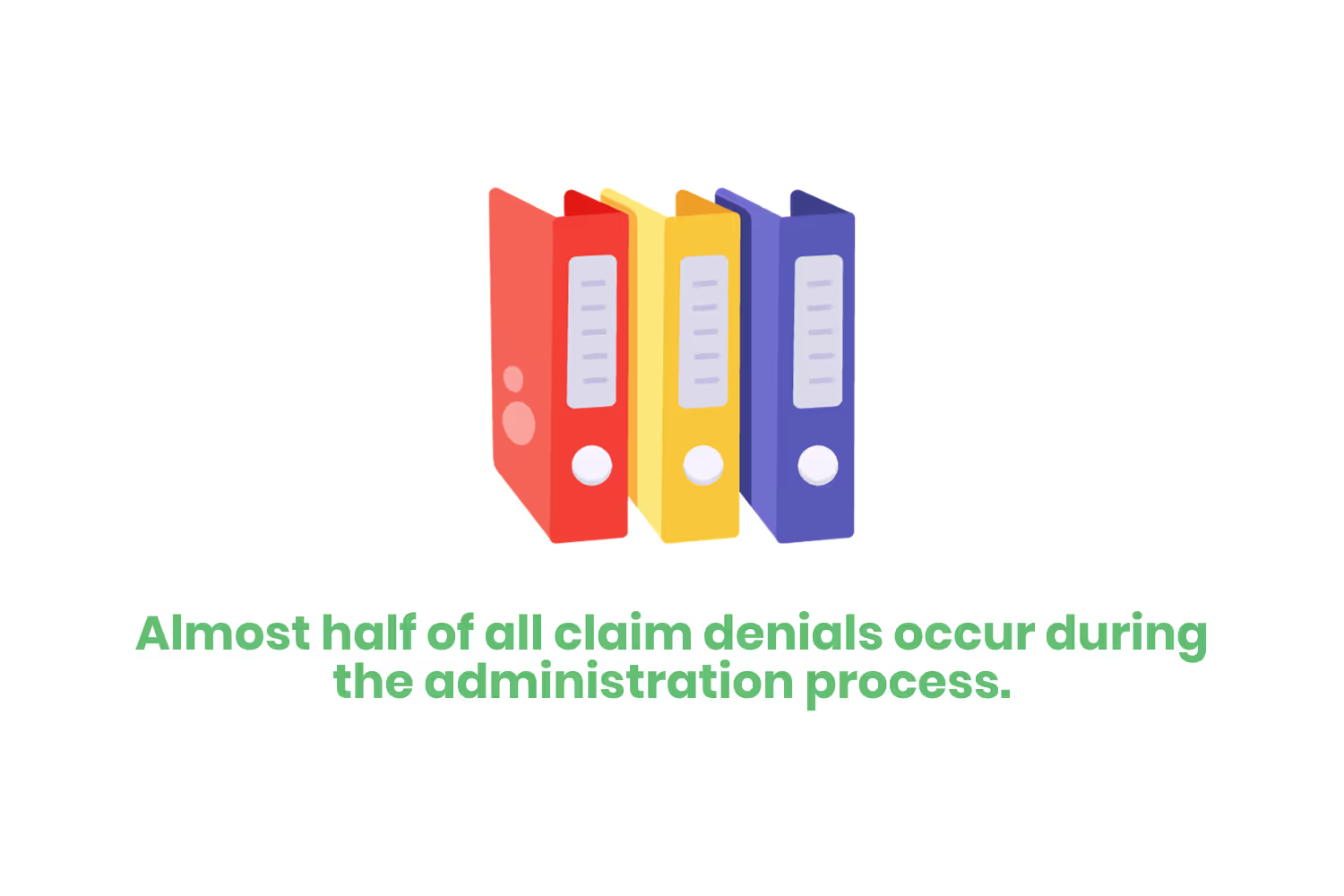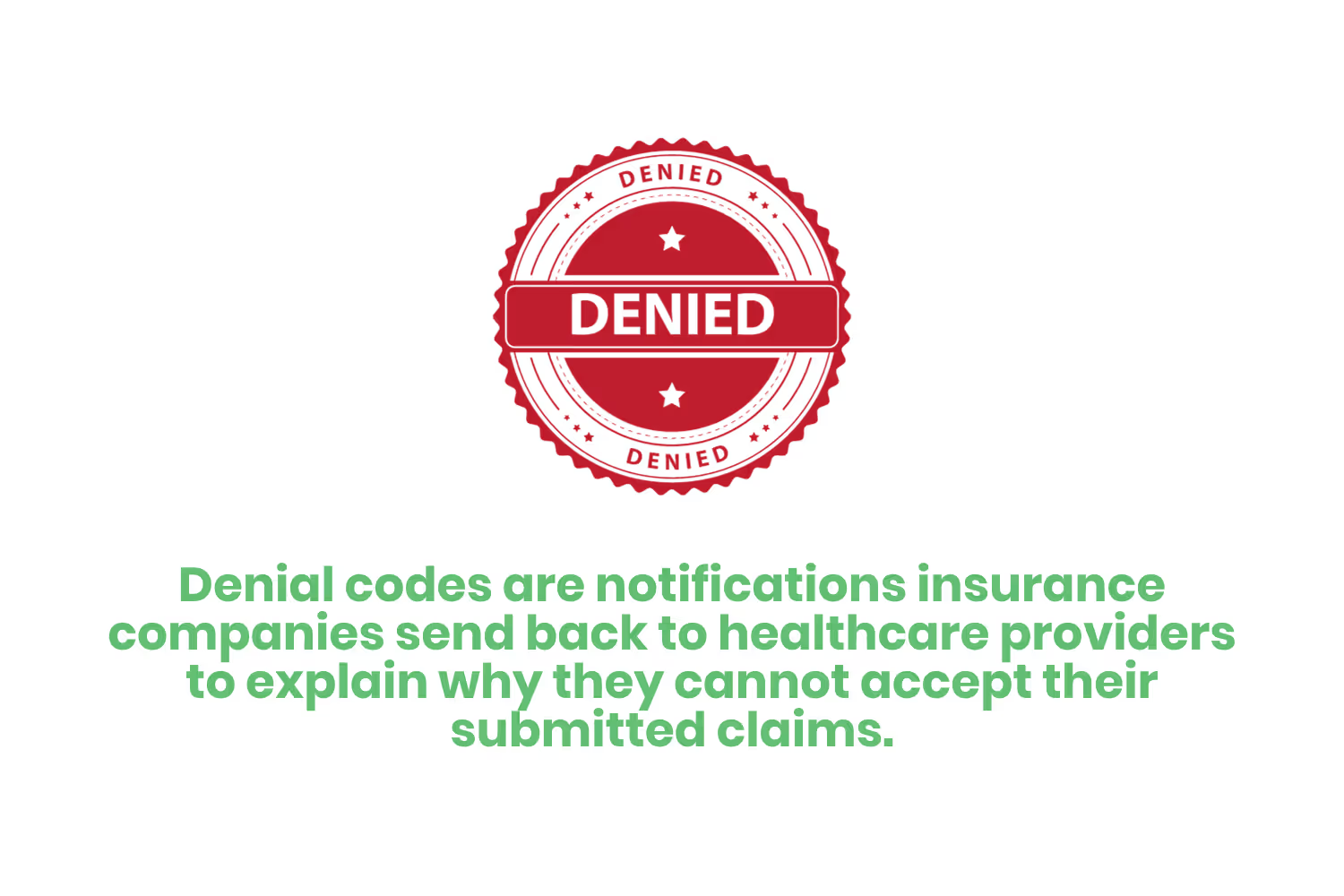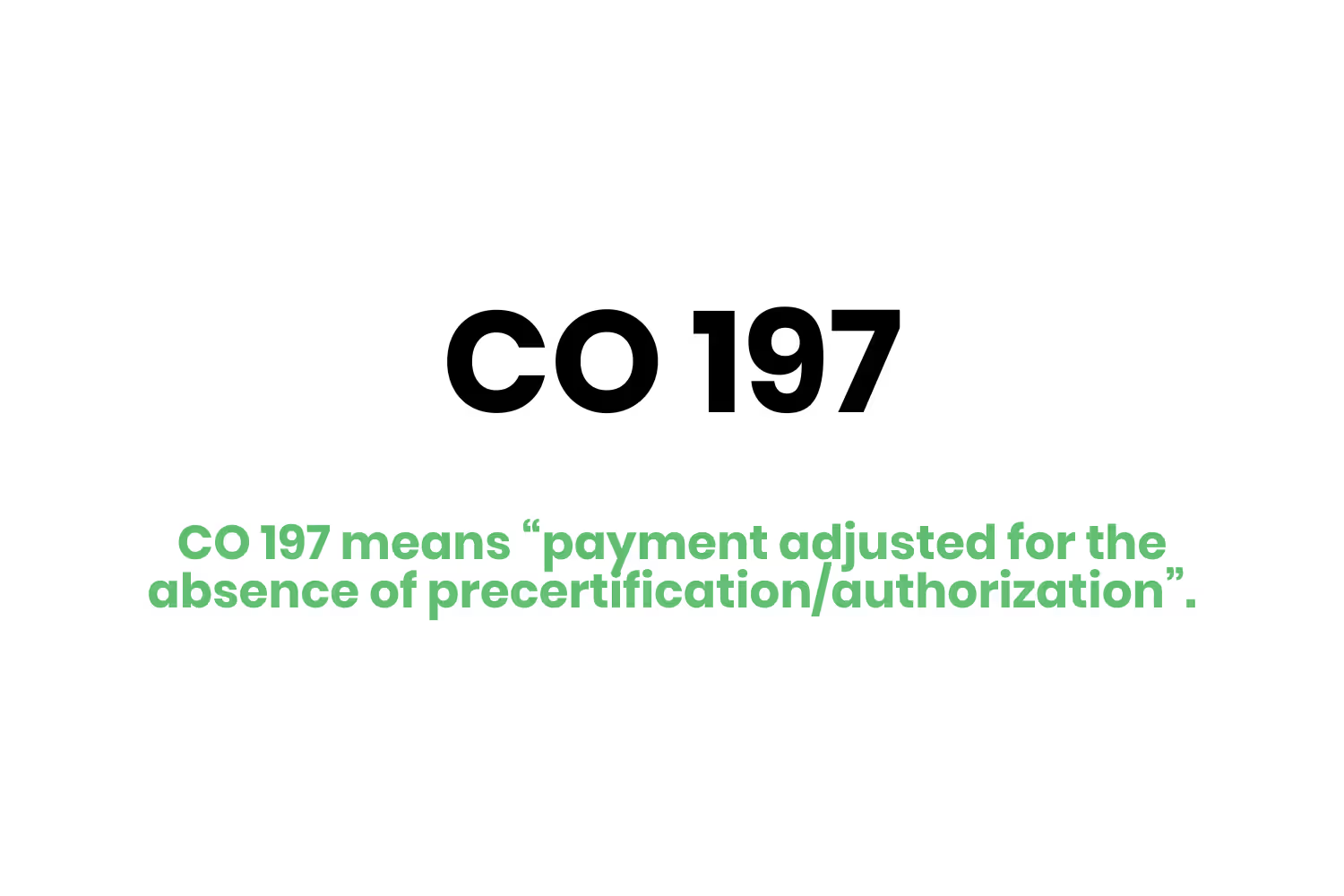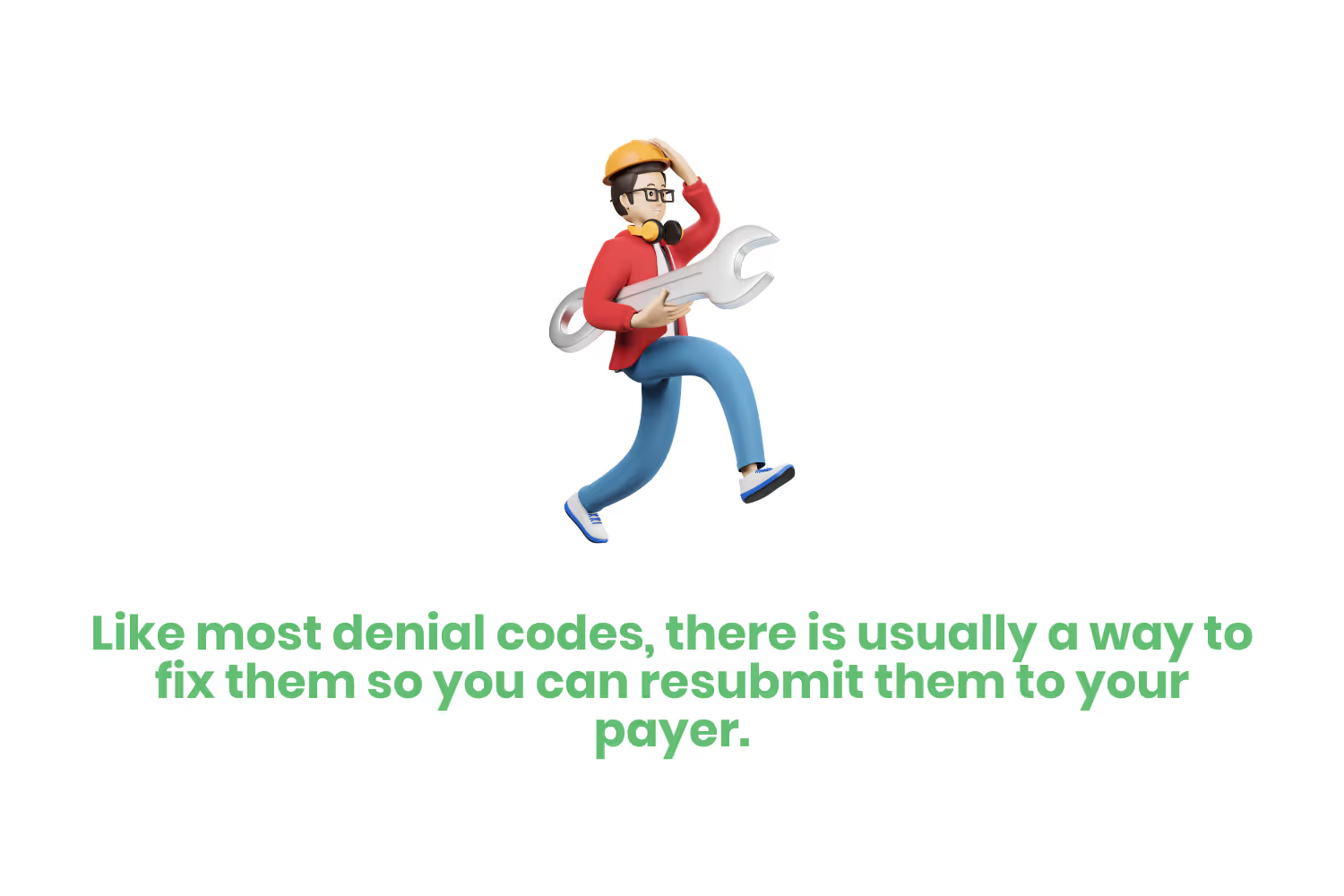Denial Code CO 197: An Ultimate Guide
Identifying the most common denial codes and streamlining processes to handle them in a timely manner, should be your first line of defense. Let’s take a look at the denial code CO 197.

Change Healthcare reports that almost half of all claim denials occur during the administration process. More than half of those denials are due to registration/eligibility issues - 22% to be exact.
Ignoring administrative claim processing issues is kind of like trying to fill a bucket with water - but there is a hole in the bottom of it. You keep trying to fill the bucket up to the top, but because of the hole, it will never get there. If you don’t fix the hole, you’re just going to waste more and more water. If you don’t fix your administrative processes, you’re just going to lose revenue.
There is nothing more irritating than dealing with the same issue over and over again. Ask any medical biller in America. That’s why taking the necessary steps to learn how to avoid these recurring front-end denials is so important. Identifying the most common denial codes and streamlining processes to handle them in a timely manner, should be your first line of defense. Let’s take a look at the denial code CO 197.

What are Denial Codes?
For those of you who are new to this and don’t really know what denial codes are, let me explain further. Denial codes are notifications insurance companies send back to healthcare providers to explain why they cannot accept their submitted claims. And there is a whole slew of denial codes, which all mean different things and have different fixes. It’s a lot to remember!
That is why medical billers and coders often have a difficult time keeping up with denial codes. After all, no one expects one person to memorize hundreds of denial codes. But what you can do is pay attention to which codes recur most often and use them as a lesson to learn from. That’s right, denial codes can actually be a good thing!

The valuable information held within these codes is the key to your practice collecting revenue. As I mentioned, they can vary for hundreds of reasons. It’s because of this that insurance companies follow a standardized format. Thankfully, this makes it easier for providers and their billing teams to file claims, no matter which insurance provider they work with.
Claim Adjustment Reason Codes (CARC) are a part of the standardized format which provides a reason for claim adjustments made by the payer. This helps medical billers understand why the claim amount is different from the billed amount.
If there is no adjustment made by the payer, there won’t be a CARC. You can find CARC descriptions in the electronic remittance advice (ERA) section and the explanation of benefits (EOB).
These group codes combined with Claim Adjustment Group Codes (CAGC) explain who is financially responsible for the claim adjustment. These CAGCS are:
- CO- Contractual Obligation.
- PR- Patient Responsibility.
- OA- Other Adjustment.
- PI- Patient Initiated Reduction.
- CR- Corrections and/or Reversal.
So when it comes to the denial code we are focusing on today, CO 197, this means that the “CO” stands for “Contractual Obligation”. This code is a valid contract between the payer and the healthcare provider which defines what services each party will cover. It is important to note that the “CO” CAGC means that providers cannot assign financial responsibility to the patient.
What is Denial Code CO 197?
Didn’t know you would be getting a free crash course in medical coding and billing, did ya? Now that you have a better handle on the practice, let’s talk about the infamous CO 197 and what exactly it means.
CO 197 means “payment adjusted for the absence of precertification/authorization”. Essentially, when you previously submitted this claim, you forgot to include the necessary authorization number. This is an administrative mistake and will take time from your everyday regimen to fix. Whoops.

Prior authorization is often required for medical services, such as surgeries. If authorization is not obtained before the service, even if only by mistake, you could miss out on reimbursement from the payer.
There are two types of authorization in medical billing:
- Prior Authorization/Pre Authorization- When a physician obtains permission for a specific medical service from the insurance company, in order to collect reimbursement, before providing the service.
- Retro Authorization- Physician obtains permission for medical service from the insurance company after they render services, in hopes of collecting on the claim.
So let’s say you got back a CO 197 denial code… then what? Let’s move on to “the fix”.
How to Fix Denial Code CO 197
Like most denial codes, there is usually a way to fix them so you can resubmit them to your payer. How else are you going to collect on that reimbursement? There are a few steps to take when considering how to move forward with your CO 197 denial code.
First, as you should do for any denial code, verify the reason you received the denial and document the denial date. In this case, you did not include an authorization number when you sent in the claim.
After you figure that out, you can look over the application again to see if there is an authorization number available for the services rendered. If it is available, great! Call the claims department, provide the authorization number and request they reprocess the claim.

If there is no authorization number, check with the payer whether you can submit retro authorization for the date of service. If yes, then you can obtain the necessary details and request the retro authorization for rendered service.
While certain insurers may grant retroactive authorization, others do not offer this option. Additionally, some insurers might reconsider a denial due to a lack of preauthorization when appealed, but it's important to note that they are typically not obligated to provide reimbursement if the preauthorization process was not adhered to.
Finally, if retro authorization is not an option, check if you can appeal the claim. To do this, make sure you have the necessary medical records, fax number, mailing address, and timely filing limit.
How to Prevent Future CO 197 Denial Codes
Now that you know what CO 197 is and how to fix it, let’s talk about how to prevent it. As luck would have it, although this denial code is common, it is also one of the easier ones to avoid.
Make sure you have that preauthorization (if the service calls for it) before you send in your claim. One way to ensure a solid preauthorization is to make sure you provide the correct CPT code. The difficulty comes into play when you have to determine the correct procedural code beforehand.

To determine the correct code before the service is provided, check with the physician to get more information on what they intend to do.
Obtaining prior authorization can look different depending on your payer’s preferences. However, usually you can submit this information through a phone call, the submission of an authorization form, or an online request. Payer portals are often the preferred method of sending in a prior authorization.
Payer policies that are found on their websites, or through the payer/provider contract, will help you determine whether a service requires authorization or not. A medical assistant or other staff should communicate medical necessity with the payer, as there needs to be an understanding of medical procedures.
Conclusion
Collecting claim denials is a huge part of any business’s management of their accounts receivable (A/R). In medical billing, this term refers to the money that still needs collecting from patients for services rendered. Following up with your A/R while keeping track of denied/rejected claims can help you receive reimbursement quickly.
By pausing to delve into the reasons behind your denials, you can proactively address issues within your policies, procedures, and staff behavior, extending from the front office to intake specialists. Maintaining a monthly FPRR exceeding 90 percent is crucial; otherwise, valuable resources may be squandered on preventable problems.
Keep in mind that while there may be instances where adding staff is warranted, prioritizing upfront issue resolution will not only boost staff morale but also prove advantageous to your bottom line.
Emphasize your product's unique features or benefits to differentiate it from competitors
In nec dictum adipiscing pharetra enim etiam scelerisque dolor purus ipsum egestas cursus vulputate arcu egestas ut eu sed mollis consectetur mattis pharetra curabitur et maecenas in mattis fames consectetur ipsum quis risus mauris aliquam ornare nisl purus at ipsum nulla accumsan consectetur vestibulum suspendisse aliquam condimentum scelerisque lacinia pellentesque vestibulum condimentum turpis ligula pharetra dictum sapien facilisis sapien at sagittis et cursus congue.
- Pharetra curabitur et maecenas in mattis fames consectetur ipsum quis risus.
- Justo urna nisi auctor consequat consectetur dolor lectus blandit.
- Eget egestas volutpat lacinia vestibulum vitae mattis hendrerit.
- Ornare elit odio tellus orci bibendum dictum id sem congue enim amet diam.
Incorporate statistics or specific numbers to highlight the effectiveness or popularity of your offering
Convallis pellentesque ullamcorper sapien sed tristique fermentum proin amet quam tincidunt feugiat vitae neque quisque odio ut pellentesque ac mauris eget lectus. Pretium arcu turpis lacus sapien sit at eu sapien duis magna nunc nibh nam non ut nibh ultrices ultrices elementum egestas enim nisl sed cursus pellentesque sit dignissim enim euismod sit et convallis sed pelis viverra quam at nisl sit pharetra enim nisl nec vestibulum posuere in volutpat sed blandit neque risus.

Use time-sensitive language to encourage immediate action, such as "Limited Time Offer
Feugiat vitae neque quisque odio ut pellentesque ac mauris eget lectus. Pretium arcu turpis lacus sapien sit at eu sapien duis magna nunc nibh nam non ut nibh ultrices ultrices elementum egestas enim nisl sed cursus pellentesque sit dignissim enim euismod sit et convallis sed pelis viverra quam at nisl sit pharetra enim nisl nec vestibulum posuere in volutpat sed blandit neque risus.
- Pharetra curabitur et maecenas in mattis fames consectetur ipsum quis risus.
- Justo urna nisi auctor consequat consectetur dolor lectus blandit.
- Eget egestas volutpat lacinia vestibulum vitae mattis hendrerit.
- Ornare elit odio tellus orci bibendum dictum id sem congue enim amet diam.
Address customer pain points directly by showing how your product solves their problems
Feugiat vitae neque quisque odio ut pellentesque ac mauris eget lectus. Pretium arcu turpis lacus sapien sit at eu sapien duis magna nunc nibh nam non ut nibh ultrices ultrices elementum egestas enim nisl sed cursus pellentesque sit dignissim enim euismod sit et convallis sed pelis viverra quam at nisl sit pharetra enim nisl nec vestibulum posuere in volutpat sed blandit neque risus.
Vel etiam vel amet aenean eget in habitasse nunc duis tellus sem turpis risus aliquam ac volutpat tellus eu faucibus ullamcorper.
Tailor titles to your ideal customer segment using phrases like "Designed for Busy Professionals
Sed pretium id nibh id sit felis vitae volutpat volutpat adipiscing at sodales neque lectus mi phasellus commodo at elit suspendisse ornare faucibus lectus purus viverra in nec aliquet commodo et sed sed nisi tempor mi pellentesque arcu viverra pretium duis enim vulputate dignissim etiam ultrices vitae neque urna proin nibh diam turpis augue lacus.




